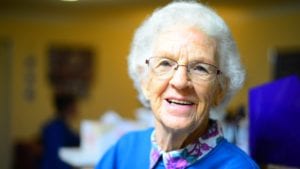Written by Marcia J. Egles, MD. Study demonstrated that six weeks of individualized music therapy significantly reduced agitation and disruptiveness and improved quality of life in the participating nursing home residents suffering from dementia.
 A recent study from Denmark and Norway demonstrated that individualized music therapy may improve symptoms of agitation in nursing home patients with dementia. In this small six week randomized controlled cross-over trial, a twice weekly intervention of individualized music therapy was shown to reduce disruptive agitation and thereby may lessen the need for pharmacological interventions 1.
A recent study from Denmark and Norway demonstrated that individualized music therapy may improve symptoms of agitation in nursing home patients with dementia. In this small six week randomized controlled cross-over trial, a twice weekly intervention of individualized music therapy was shown to reduce disruptive agitation and thereby may lessen the need for pharmacological interventions 1.
The Alzheimer’s Disease International (ADI) World Report of 2012 estimates that 36 million persons worldwide have dementia 2. Approximately 80% of nursing home patients are afflicted with dementia. Agitation is one of the most significant symptoms causing both patient distress and caregiver burden 3.
Forty- two nursing home residents with moderate to severe dementia, aged 66 to 96 years, 69% female, were randomly assigned to either 6 weeks of individual music therapy or 6 weeks of standard care. After the 6 weeks, the two groups then switched treatments, receiving 6 more weeks of either standard care or the individualized music therapy in a “cross-over” study design fashion.
The individualized music therapy was conducted by experienced therapists with Master’s degrees in music therapy and qualifications in dementia care. The components of the therapy included twice weekly 30 minute sessions with a “person-centered” approach with interactions adjusted to the needs of each individual patient. Musical activities included both active singing, dancing and instrument playing as well as more passive listening to music. For some patients, their regular ‘standard care” included group music therapy such as weekly group sing-a-long activities. These patients continued in their group sessions as usual in this study.
Outcome measures included agitation frequency, quality of life, and amounts of psychoactive medications required. Agitation frequency was assessed by a proxy caregiver in a phone interview with a researcher using the CMAI nursing home form 4,5 which quantitates 29 agitated behaviors with a 7- point frequency scale and a 5-point disruptiveness scale. The maximum score for the frequency scale is 66 points. The maximum score for the agitation disruption is 44 points. The phone interviewers were not informed as to which treatment arm the patient was receiving. Likewise “Quality of Life” assessment was performed in the same caregiver/researcher phone interview using the ADRQL scale 6. The phone interviews were conducted one week after completion of the 6 week sessions. For each participant, medications were reviewed and compared from the start of the study and again after the conclusion at 14 weeks. Thirty-five residents completed the study.
Overall, during standard care, the frequency of agitated behavior as measured by the CMAI scale showed a slight increase at 0.43 points with standard care but decreased with music therapy at -2.96 points. These differences were not enough to be statistically significant. The analysis of the CMAI disruptiveness scale did meet statistical significance (p=0.027) with an increase of 3.26 points for standard care versus a decrease in agitated disruptiveness of -3.51 points for the music therapy. The differences in the quality of life scale ADRQL did not reach statistical significance.
A significant (p=0.02) increase in psychotropic medication was registered during standard care, but no increases were registered during the sessions of music therapy. For two participants, a reduction in psychiatric medications occurred in the music therapy period.
This study shows that six weeks of individualized music therapy significantly reduced average agitation disruptiveness scores in persons with dementia as compared to standard care. This study suggests that music therapy might be a valuable aid in reducing the use of psychotropic drugs in these patients.
Source: Ridder, Hanne Mette O., Brynjulf Stige, Liv Gunnhild Qvale, and Christian Gold. “Individual music therapy for agitation in dementia: an exploratory randomized controlled trial.” Aging & mental health 17, no. 6 (2013): 667-678.
© 2013 Taylor & Francis
Posted July 16, 2018.
Marcia Egles, MD, graduated from Vanderbilt University School of Medicine in 1986. She completed her residency in Internal Medicine at St. Louis University Hospital. Dr. Egles is certified in Internal Medicine and is a member of the American College of Physicians. She resides in Avon, IN with her husband and two sons.
References:
- Ridder HMO, Stige B, Qvale LG, Gold C. Individual music therapy for agitation in dementia: an exploratory randomized controlled trial. Aging & mental health. 2013;17(6):667-678.
- Batsch N, Mittelman M. World Alzheimer report: Overcoming the stigma of dementia. Alzheimer’s Disease International; 2012.
- Quince C. Low Expectations: Attitudes on Choice, Care and Community for People with Dementia in Care Homes. 2013.
- Cohen-Mansfield J. Instruction manual for the Cohen-Mansfield agitation inventory (CMAI). Research Institute of the Hebrew Home of Greater Washington. 1991.
- Cohen‐Mansfield J, Libin A. Assessment of agitation in elderly patients with dementia: correlations between informant rating and direct observation. International Journal of Geriatric Psychiatry. 2004;19(9):881-891.
- Rabins PV, Kasper JD, Kleinman L, Black BS, Patrick DL. Concepts and methods in the development of the ADRQL: an instrument for assessing health-related quality of life in persons with Alzheimer’s disease. Journal of Mental Health and Aging. 1999.
